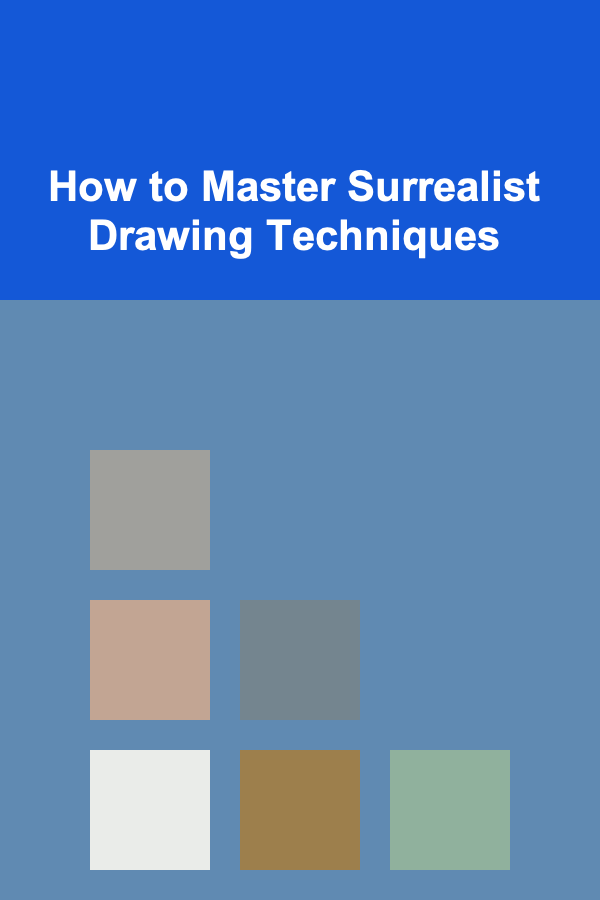
How to Master Surrealist Drawing Techniques
ebook include PDF & Audio bundle (Micro Guide)
$12.99$10.99
Limited Time Offer! Order within the next:

Surrealism, a cultural and artistic movement that began in the early 20th century, has profoundly impacted the world of visual art. Known for its bizarre, dream-like qualities and an exploration of the unconscious mind, surrealism pushes the boundaries of reality and imagination. Surrealist drawing, specifically, has fascinated artists and art enthusiasts for decades due to its ability to provoke thought, spark creativity, and present new ways of seeing the world.
Mastering surrealist drawing techniques is not only about creating unusual, impossible images but also about developing the ability to express deeper psychological and emotional states. In this article, we will explore the key principles and techniques of surrealist drawing, offering insights on how to master the practice and create compelling, thought-provoking artwork.
Understanding Surrealism
Before diving into techniques, it's essential to understand the foundation of surrealism. Surrealism began as a literary movement led by André Breton in the 1920s, primarily as a response to the rationalism and logic that dominated the period. It sought to challenge conventional thinking by tapping into the unconscious, exploring dreams, and blurring the lines between reality and fantasy.
Artists like Salvador Dalí, René Magritte, and Max Ernst became key figures in the movement, employing symbolism, unusual perspectives, and irrational imagery. In surrealist drawings, objects and forms are often distorted or combined in illogical ways, revealing hidden truths about the subconscious mind.
Mastering surrealism, therefore, is not just about technical skill; it's about embracing the irrational, the illogical, and the mystical aspects of creativity.
Key Principles of Surrealist Drawing
While surrealism does not have rigid rules, there are key principles that artists typically follow when creating surrealist works. These principles guide how artists blend the real with the imagined and how they approach drawing.
2.1. The Subconscious Mind
Surrealism often emphasizes the exploration of the subconscious. Techniques like free association, automatic drawing, and dream analysis are employed to unlock the unconscious mind's hidden desires, fears, and thoughts. When drawing in a surrealist style, artists focus on allowing their mind to wander, trusting their instincts to guide their work.
2.2. Dream-Like Imagery
A hallmark of surrealist art is the use of dream-like imagery, inspired by the irrational nature of dreams. Artists often draw inspiration from dreams, where logic is suspended and bizarre scenarios unfold. Incorporating unexpected juxtapositions, distorted proportions, or non-linear time can help evoke that dream-like quality in your drawings.
2.3. Free Association
In surrealist drawing, free association involves creating artwork without a preconceived plan, allowing the mind to flow freely and without restriction. This technique can help artists create images that are unfiltered and spontaneous, resulting in a sense of freedom and creativity that reflects the core values of surrealism.
2.4. Juxtaposition
One of the most notable techniques in surrealism is the juxtaposition of unrelated objects or ideas. By placing familiar objects in unfamiliar contexts, surrealist artists challenge viewers to question their assumptions about reality. For example, Dalí's "The Persistence of Memory" places soft, melting clocks in a barren landscape, defying logic and normal expectations. To master surrealism, experimenting with unlikely combinations in your own drawings will help you master this technique.
Surrealist Drawing Techniques
3.1. Automatic Drawing
Automatic drawing, also known as spontaneous or free-flow drawing, is a technique developed by surrealists like André Masson. This method involves drawing without conscious control, allowing the hand to move freely across the page. The goal is to bypass the critical mind and tap into the subconscious.
To practice automatic drawing:
- Relax your mind and focus on your inner thoughts without worrying about creating a specific image.
- Let your hand move without thinking or planning. The resulting lines and shapes should come naturally, without judgment or control.
- After completing the drawing, step back and analyze what you see. You may uncover hidden patterns, shapes, or images that are meaningful or symbolic.
3.2. Collage and Cut-Outs
Another technique used by surrealist artists is collage, which involves combining different materials, textures, and images to create a new, often unexpected composition. Max Ernst, for instance, used collage as a way to explore surrealist themes by cutting and pasting images from magazines and newspapers.
To create a surrealist collage:
- Gather various materials, including photographs, illustrations, textures, and even text.
- Cut and arrange these materials in a way that creates an unexpected and striking composition. Don't be afraid to place unrelated items together.
- Glue the pieces onto a surface, either as part of a drawing or as an entirely separate piece of art.
Collages allow for a surreal combination of imagery, and the juxtaposition of seemingly random elements is one of the most effective ways to challenge the viewer's sense of reality.
3.3. Dislocation and Distortion
In surrealist drawings, dislocation and distortion are often used to bend or manipulate the rules of reality. This technique involves exaggerating proportions, manipulating time and space, or placing objects in unexpected settings.
For example, you might:
- Stretch, twist, or warp the shapes and sizes of familiar objects. A human figure might have elongated limbs, or a tree might have an impossible twist.
- Alter the surroundings or the scale. A small object could appear colossal in contrast to the environment.
- Use impossible perspectives, such as objects floating in mid-air or merging together in ways that defy logic.
Dislocation and distortion help transform the ordinary into the extraordinary, creating surreal and compelling imagery.
3.4. Symbolism and Metaphor
Surrealist artists often use symbols and metaphors to convey deeper meanings. These symbols can carry personal, psychological, or even universal significance. For instance, objects like clocks, eyes, or doors often appear in surrealist art as metaphors for concepts such as time, perception, or transition.
When drawing in a surrealist style:
- Use symbolic elements in your artwork. These symbols can represent personal experiences, emotions, or abstract concepts.
- Be intentional about the meaning behind each symbol, but also allow for ambiguity. Surrealist drawings often leave room for interpretation and invite viewers to derive their own understanding.
- Experiment with symbolism that is unique to you, whether it's rooted in mythology, personal experiences, or abstract thoughts.
3.5. Transformation and Metamorphosis
Transformation, or metamorphosis, is another key theme in surrealism. Objects in surrealist art often shift forms or transform into something entirely different. This technique can evoke a sense of fluidity and change, which aligns with the surrealist view of a constantly shifting and evolving reality.
To use metamorphosis in your drawings:
- Start with a recognizable object or figure, then transform it into something unexpected. For instance, a human figure could morph into an animal or a tree might turn into a face.
- Experiment with transitions between different forms. Use gradual shifts or abrupt changes to convey the idea of transformation.
- Play with the concept of duality---create images where something can be both one thing and another simultaneously.
3.6. Double Exposure and Visual Ambiguity
Inspired by techniques from photography, surrealists often used double exposure to create layered images that evoke a sense of mystery. This technique involves combining two or more images into one frame, often creating a visual puzzle or illusion.
To achieve visual ambiguity:
- Layer different images over each other, either through drawing or digital manipulation.
- Allow elements from one image to merge with another, creating a surreal effect.
- Focus on ambiguity and paradox in your work. Create scenes where the boundaries between objects are unclear or fluid.
This technique challenges the viewer's perception and invites them to interpret the artwork from multiple angles.
Finding Your Own Surrealist Voice
Surrealism is ultimately about self-expression and tapping into your personal unconscious. As you practice surrealist drawing, it's important to find your own voice and style. Rather than simply imitating the great surrealists, focus on developing an approach that feels authentic to you.
Here are some tips to help you find your unique surrealist style:
- Reflect on your own dreams, thoughts, and emotions. What imagery resonates with you? What symbols or metaphors appear in your mind?
- Experiment with different techniques and approaches, but be patient and allow your style to evolve organically.
- Embrace the unexpected. Surrealism thrives on spontaneity and unpredictability, so be open to the surprises that come from your subconscious.
Conclusion
Mastering surrealist drawing techniques is a journey into the depths of your imagination, dreams, and subconscious mind. By employing automatic drawing, collage, dislocation, symbolism, and metamorphosis, you can create visually striking works of art that challenge conventional notions of reality and invite viewers to explore the unknown.
Surrealism is more than just a style---it's a way of thinking, seeing, and experiencing the world. As you continue to practice and experiment with these techniques, you'll unlock new creative possibilities and develop a deeper connection to the surreal world within and around you. Whether you're an experienced artist or a beginner, surrealist drawing offers endless opportunities to express your inner landscape and redefine the boundaries of art.

How to Make Money by Developing AI-Powered Applications
Read More
How to Make the Most of Your Employer's Retirement Benefits
Read More
How to Minimize Distractions While Working from Home
Read More
How to Set Up a Mobile Craft Station for On-the-Go Creativity
Read More
How to Sketch Your Pets: A Loving Guide
Read More
How to Explore Blockchain for Copyright Protection
Read MoreOther Products

How to Make Money by Developing AI-Powered Applications
Read More
How to Make the Most of Your Employer's Retirement Benefits
Read More
How to Minimize Distractions While Working from Home
Read More
How to Set Up a Mobile Craft Station for On-the-Go Creativity
Read More
How to Sketch Your Pets: A Loving Guide
Read More